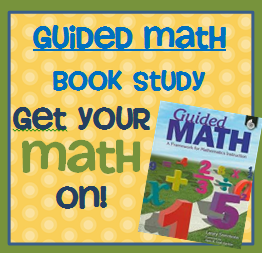I'm linking up with
Primary Gal for her book study on Laney Sammons Guided Math book.
Note: This is a post from last summer with a few updates. Today was my last day with kids and I am exhausted so I'm recycling! When I was preparing to switch from 4th grade to 1st grade many years ago, the importance of a print-rich classroom was drilled into my brain. Each year as I set up my classroom I considered how to create an environment that focused on literacy. But other than the required Every Day Counts calendar, no one ever seemed to think about making the classroom math friendly.
But in this chapter, Laney explains the importance of also creating a classroom environment of numeracy and gives us the foundational principles of Guided Math.
One of the biggest ideas in this chapter is the importance of communication in math. The NCTM Communication Standard states that programs should enable students to:
- organize and consolidate their mathematical thinking trhough communciation
- communicate their mathematical thinking coherently and clearly to peers, teachers and others
- analyze and evaluate the mathematical thinking and strategies of others
- use the language of mathematics to express mathematical ideas
Our Texas TEKS state that the student is expected to:
- communicate mathematical ideas, reasoning, and their implications using multiple representations, including symbols, diagrams, graphs, and language as appropriate;
- create and use representations to organize, record, and communicate mathematical ideas;
- analyze mathematical relationships to connect and communicate mathematical ideas; and
- display, explain, and justify mathematical ideas and arguments using precise mathematical language in written or oral communication.
Here are two books that I have found helpful this year for encouraging math talk:
Edited to add: I really love these dot cards by Donna Boucher at The Math Coach's Corner! We used them a lot for warm ups and to talk about addition strategies.
The rest of the chapter explains how to set up a classroom that will promote literacy. Just like literacy instruction, math requires a large group area, a small group area and an area for students to work independently or with a group or partner. I arranged my large group area this year so that we could use the Smart Board for whole group lessons as well as an easel. My guided reading table also served as the meeting place for small groups in math. I kept two sets of storage drawers behind my table; one for guided reading matherials and the other for math manipulatives and other supplies for guided math. Student desks were grouped in clusters, and there was plenty of floor space for students to work with a partner at math stations or problem solving.
Organization is crucial! Students need easy access to manipulatives during math activities. I keep all of mine in labeled plastic storage containers on a counter in my classroom. Students also have a math toolkit in their desks with counters, number lines and other frequently used materials. (An idea from Kim Sutton!)
Math anchor charts are displayed throughout the room. This year I hope to add a word wall dedicated to math vocabulary.
I didn't get a whole word wall set up, but I did add vocabulary to my math focus wall. Math stretches or problems of the day/week can also be displayed so that students can work on them throughout the day.
This year I added Think Math- the kids loved it! Journals provided a place for students to solve problems and explain their thinking using words, pictures, diagrams, etc.
 |
| My manipulatives and math tubs. The pocket chart is used for math station rotations. |
 |
| A chart we created early in the year. |
This chapter was so full of information, and I feel like I've just skimmed the surface!
Questions to think about:
1. How do visitors to your classroom know that math is valued?
2. What ideas to you have or use for encouraging communication in math?
3. Do you have any organizational tips for math manipulatives or guided math?
I can't wait to hear your thoughts!






























